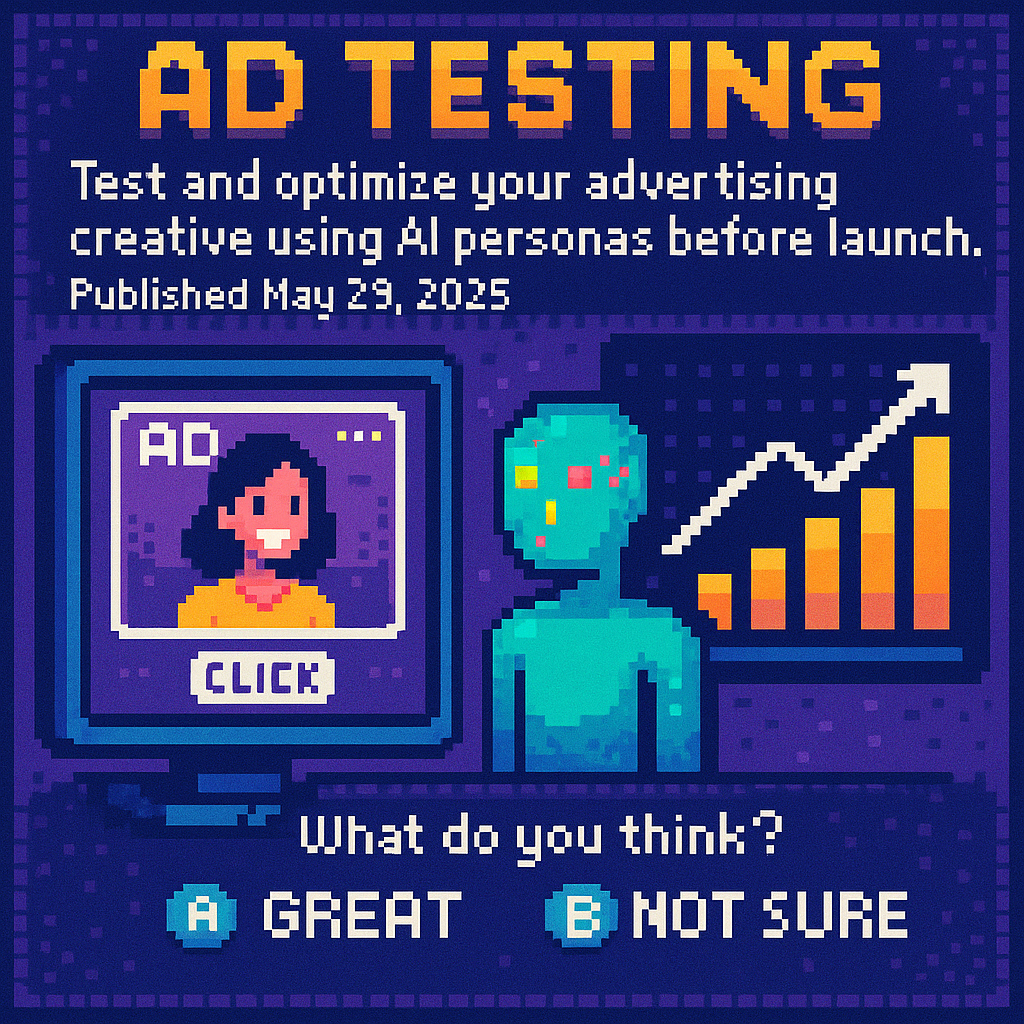Ad Testing
Test and optimize your advertising creative using AI personas before launch. This synthetic research approach reveals which ads resonate most strongly with your target market, identifies performance drivers, and helps you choose winning creative concepts without the cost and time of traditional ad testing with real respondents.

What is it Used For?
Ad testing evaluates consumer response to advertising creative before launch, helping businesses maximize campaign effectiveness and return on ad spend. This market research methodology validates creative concepts by measuring appeal, memorability, and engagement among target audiences. Companies use ad testing to screen multiple creative directions and identify winners before investing in media spend, test different messaging strategies, visual approaches, and creative formats to find what resonates most strongly, evaluate headlines, imagery, video concepts, and call-to-action elements to optimize each component, assess brand recall and message clarity to ensure ads communicate the intended message, validate emotional impact and purchase intent to predict real-world campaign performance, and reduce the risk of costly campaign failures by catching creative problems before launch. The methodology works particularly well for display ads, video campaigns, social media creative, outdoor advertising, and any situation where creative execution significantly impacts campaign success and media investment.
Real-World Example
How to Conduct This Research in Ask Rally
Step 1: Define Your Creative Testing Scope
Start by clarifying what elements you want to test - complete ad concepts, specific headlines, visual approaches, or individual components. Consider your campaign objectives, target metrics, and the creative decisions that will most impact performance.
Step 2: Generate Your Target Personas
Create AI personas that match your advertising target audience. Include demographics, psychographics, media consumption habits, and purchase behaviors. For comprehensive testing, generate 200-500 personas across different segments to capture audience diversity.
Step 3: Prepare Your Creative Variations
Develop multiple ad concepts or variations to test. Include different visual approaches, messaging strategies, emotional tones, and creative formats. Test 5-20 variations depending on your scope - enough to identify clear winners without overwhelming personas.
Step 4: Present Ads in Realistic Context
Show personas your ad creative as they would encounter it in real media environments. Include surrounding context like social media feeds, website placements, or video pre-roll scenarios to get authentic reactions.
Step 5: Measure Core Ad Performance Metrics
Evaluate each creative on dimensions that predict campaign success: immediate attention and visual appeal, message clarity and understanding, emotional impact and brand association, memorability and recall potential, relevance to personal needs, and likelihood to take action or engage. Ask personas to explain their reasoning to understand performance drivers.
Step 6: Test Individual Creative Elements
Beyond overall ad performance, isolate specific components like headlines, images, call-to-action buttons, or video thumbnails. Understanding which elements drive performance helps optimize future creative development.
Step 7: Analyze Performance Patterns
Look for creative concepts that score consistently high across multiple metrics and persona segments. Identify which creative elements, messaging approaches, or visual styles drive the strongest positive responses.
Step 8: Validate Emotional Response
Test not just rational appeal but emotional impact. Measure how ads make personas feel and whether they create the intended brand associations. Emotional connection often predicts real-world campaign performance better than rational metrics alone.
Step 9: Segment by Audience Response
Analyze how different persona segments respond to each creative. Look for opportunities to use different ads for different audiences or identify creative approaches that work across all segments.
Step 10: Plan for Creative Refresh
Use insights to guide your ongoing creative development. Understand what makes concepts work so you can iterate and refresh before creative fatigue sets in.
Starter Prompt Template
Use this prompt template to get started with ad testing in Ask Rally:
Stay Updated
Subscribe to our newsletter to get notified about new articles and updates.
